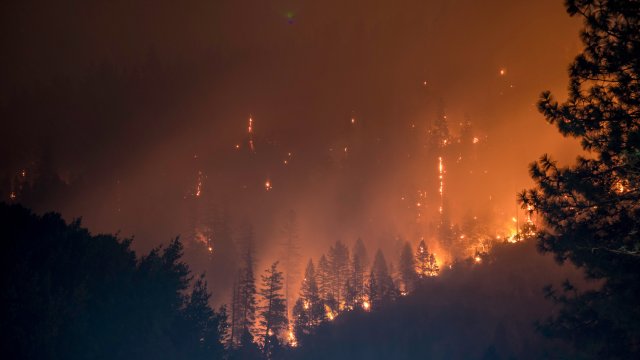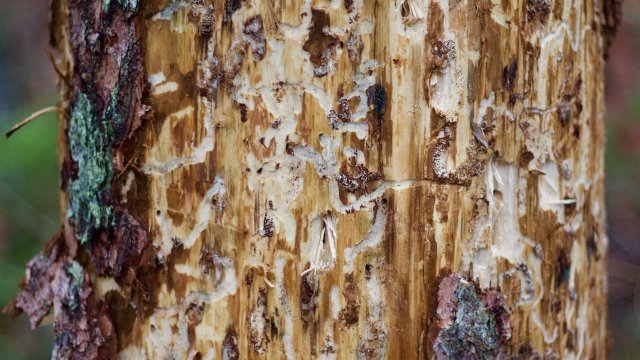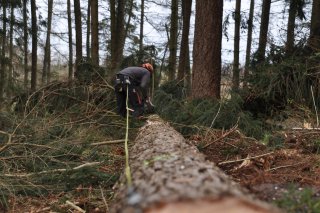Climate Change Impacts on Forests
Overview
Forests and woodlands cover more than 822 million acres of land in the United States—about 36% of the country’s total land.1 There are many types of forests, including tropical forests, pine forests, and deciduous forests, with trees that shed their leaves annually. Forests are found on coasts, in wetlands, in dry inland regions, in areas with cold and warm climates, and even in cities.2
-

Forest structure changes. In the U.S. Southeast, sea level rise and warmer weather could cause mangrove forests to spread into salt marshes along the coast.38 This could change the balance of other species living in these ecosystems.39
-

Economic impacts. Outdoor activities can be a key source of income for rural areas. In northwest Massachusetts, communities banded together to create the Mohawk Trail Woodlands Partnerships to help keep the region’s forests—and economy—healthy.40
-

Forest losses from wildfires. In 2020, wildfires burned over 10 million acres of U.S. lands, the highest-ever amount on record.41 Wildfires are expected to become more frequent and intense as the climate warms.42
-

Insect damage to trees. Bark beetles eat away at trees.43 As the climate changes, warmer temperatures can lead to bark beetle population growth.44 Since 2000, bark beetles are thought to have damaged as much forest area as wildfires.45
-

More invasive species in forests. In the northeastern and midwestern United States, invasive garlic mustard plants can take nutrients away from native species.46 As climate change leads to changes in forest health, invasive species may spread more easily.47
Forests provide clean air and water, recreational opportunities, food, goods, and (ecosystem) services. Forests also connect people with nature and play an important role in the culture and survival of some Indigenous peoples.
Climate plays an important role in the makeup, function, and health of forests. Therefore, changes in climate, such as in temperature and precipitation, can have direct impacts on forests. These impacts vary by region and forest type. Some impacts may be beneficial while others could be damaging. For example, a warmer climate may increase tree growth in some forests but decrease it in others.3
Some forests and individual species may be able to respond to climate changes more successfully than others. Forests that are fragmented into smaller patches may be less able to adapt than those that are well connected.4 People can take many steps to manage forests sustainably for different uses and to be more resilient to climate change.5
Explore the sections on this page to learn more about climate impacts on forests:
- Top Climate Impacts on Forests
- Forests and the Economy
- Environmental Justice and Equity
- What We Can Do
- Related Resources
Top Climate Impacts on Forests
Climate change may affect forests at both local and regional scales. The impacts can vary even within a single forest. Three key impacts are described in this section.
1. Natural Disturbances
Climate change will influence a number of natural disturbances that threaten forest health. These include insect outbreaks, invasive species, wildfires, and storms.7 Some disturbances, like a wildfire, take place quickly. Others, like changes in animal or plant populations, happen over decades to centuries.8 Some of their effects may be temporary, allowing a forest to recover. In other cases, a forest may suffer lasting impacts.9
Some forests may benefit from certain climate impacts. For instance, warmer temperatures can lead to more tree and plant growth in regions where cold weather limits the growing season.10 However, in other forests, warmer temperatures may allow invasive species to thrive.11,12 Warmer weather can also encourage insect survival and growth. Over the past decade, climate change has led to an increase in bark beetle damage to mountain pines in parts of the West.13
Disturbances can also interact with one another to increase risks to forests. For example, drought can weaken trees and make a forest more vulnerable to wildfire or insect outbreaks. Similarly, wildfires can make a forest more vulnerable to pests.14 Climate impacts can also interact with other stressors, like land development, that decrease a forest’s ability to adapt.15
2. Reduced Carbon Storage
Climate change is expected to affect forests’ ability to provide key ecosystem services, including carbon storage, clean air, water supply, recreation, and wildlife habitat.16 One of the most important ecosystem services forests provide is absorbing carbon dioxide from the atmosphere and storing it in roots, soil, aboveground tree growth, and the forest floor.17
Climate change can affect carbon storage in several ways. For example, it may bring more frequent and intense rainfall to some regions.18 Heavy precipitation and flooding can erode forest soils and cause stored carbon to be released back into the atmosphere.19 Damage to forests from more wildfires, insects, and disease outbreaks can also release stored carbon.
3. Impacts on Water Resources

Another key ecosystem service that forests provide is water for drinking, irrigation, recreation, and other uses. Forest watersheds also moderate extreme weather impacts, such as flooding from heavy rainfall, on downstream communities and ecosystems.20
Droughts, wildfires, rising temperatures, and reduced snowfall and snowpack due to climate change can all limit a watershed’s ability to provide these services.21 For example, more frequent or severe droughts could reduce streamflow in some forests. Less streamflow means less water may be available for people to use. Reduced streamflow can also affect some plants and animals, such as fish that migrate to certain streams to reproduce.22
For more specific examples of climate change impacts in your region, please see the National Climate Assessment.
Forests and the Economy

Every day, Americans use a wide array of forest products including paper and packaging materials, lumber, and construction materials.24 The forest-products industry employs over 900,000 people in the United States.25 It also generates over $190 billion a year in sales and makes up about 4.5% of the total U.S. manufacturing gross domestic product.26
In addition, forests provide important ecosystem services, such as clean air and water, climate regulation, wildlife habitat, and carbon storage. These services are often perceived as “free,” but they have great value. Some forests also provide opportunities for outdoor recreation, a source of revenue and economic growth for many regions.27
Environmental Justice and Equity

Certain communities may be more affected by climate change impacts on forests than others. For example, some Indigenous peoples rely on forests for medicine, food, or ceremonial practices.28,29If they cannot access these resources, their diet, mental health, and cultural identity may be impacted. 30 Tribes in remote or rural areas may already lack access to wastewater-treatment services and safe drinking water supplies.31 Climate impacts on the forest watershed can worsen these Tribes’ water security.
Many rural communities benefit from their location near scenic forests.32 Climate change impacts on these forests may disrupt tourism and outdoor activities that are key sources of revenue for these communities.
Urban forests—such as parks, gardens, and nature preserves—provide important benefits to neighborhoods within cities.33 As the climate changes, impacts like extreme weather, heat, and soil and air quality changes can stress urban forests. This may affect their ability to provide cooling and other key services, particularly for those people most in need.34 For example, low-income households may be less able to afford air conditioning.35 People with certain medical conditions can also be more sensitive to heat, putting them at greater risk.36
What We Can Do

We can reduce climate change’s impacts on forests and improve the resiliency of forested areas in many ways, including the following:
- Adopt climate-smart forestry practices. Forest owners and managers can use strategic forest management options, such as removing wildfire fuel, thinning trees, or managing controlled burns, to address the specific climate change vulnerabilities facing that area.37 Urban forest managers can also take steps to maximize their ecological benefits.
- Reduce wildfire risk. Be aware of where and when weather conditions may increase the risk of wildfire, and take steps to reduce the likelihood of causing a wildfire. For example, keep campfires small and put them out completely before leaving an area.
- Protect forest watersheds. Explore EPA’s Healthy Watersheds Program to learn about watersheds in your area and how to protect them.
- Prevent spread of invasive species. Help prevent invasive species from entering forest land. Clean clothing and shoes before entering and leaving a forest, and stay on marked trails.
- Control pests. Forest owners and managers can use integrated pest management practices to help control pest outbreaks while reducing pesticide use.
See additional actions you can take, as well as steps that companies can take, on EPA’s What You Can Do About Climate Change page.
Related Resources
- Fifth National Climate Assessment, Chapter 7: “Forests.”
- U.S. Department of Agriculture (USDA) Forest Service. Manages national forests and public grasslands. Also provides technical and financial assistance to state and private forestry agencies.
- EPA’s Recreation Economy for Rural Communities program. Helps towns foster outdoor recreation and tourism while conserving forests.
- U.S. Forest Service: Forest Stewardship Program. Works in partnership with many groups to provide tools and information to help manage forests. One tool, the USDA Drought Summary Tool, shows drought conditions over time by region, state, range, and forest.
- National Wildfire Coordinating Group: Incident Information System. An interagency system that provides wildfire locations, prescribed fire projects, and burned area emergency response incidents across the contiguous United States.
- Environmental Protection in Indian Country. Provides information for Tribes on environmental protection programs, grant programs, community resources, and environmental topics of interest.
Endnotes
1 Oswalt, Sonja N.; Smith, W. Brad; Miles, Patrick D.; Pugh, Scott A. (2019). Forest Resources of the United States, 2017: a technical document supporting the Forest Service 2020 RPA Assessment. Gen. Tech. Rep. WO-97. Washington, DC: U.S. Department of Agriculture, Forest Service, Washington Office., p. 4
2 Tidwell, T. (2016). State of forests and forestry in the United States. USDA, Forest Service. Retrieved 3/21/2021.
3 Vose, J.M., et al. (2018). Ch. 6: Forests. In: Impacts, risks, and adaptation in the United States: Fourth national climate assessment, volume II. U.S. Global Change Research Program, Washington, DC, p. 243.
4 Butler-Leopold, P.R., et al. (2018). Mid-Atlantic forest ecosystem vulnerability assessment and synthesis: A report from the Mid-Atlantic Climate Change Response Framework project. USDA, Forest Service, Newtown Square, PA, pp. 142–143.
5 Domke, G. M., et al. (2023). Ch. 7: Forests. Fifth National Climate Assessment. U.S. Global Change Research Program, Washington, DC, p. 7-20.
6 Domke, G. M., et al. (2023). Ch. 7: Forests. Fifth National Climate Assessment. U.S. Global Change Research Program, Washington, DC, p. 7-16.
7 Domke, G. M., et al. (2023). Ch. 7: Forests. Fifth National Climate Assessment. U.S. Global Change Research Program, Washington, DC, p. 7-8.
8 Vose, J.M., et al. (2018). Ch. 6: Forests. In: Impacts, risks, and adaptation in the United States: Fourth national climate assessment, volume II. U.S. Global Change Research Program, Washington, DC, p. 240.
9 Domke, G. M., et al. (2023). Ch. 7: Forests. Fifth National Climate Assessment. U.S. Global Change Research Program, Washington, DC, 7-8.
10 Vose, J.M., et al. (2018). Ch. 6: Forests. In: Impacts, risks, and adaptation in the United States: Fourth national climate assessment, volume II. U.S. Global Change Research Program, Washington, DC, p. 243.
11 Domke, G. M., et al. (2023). Ch. 7: Forests. Fifth National Climate Assessment. U.S. Global Change Research Program, Washington, DC, p. 7-10.
12 Butler-Leopold, P.R., et al. (2018). Mid-Atlantic forest ecosystem vulnerability assessment and synthesis: A report from the Mid-Atlantic Climate Change Response Framework project. USDA, Forest Service, Newtown Square, PA, p. 129.
13 Domke, G. M., et al. (2023). Ch. 7: Forests. Fifth National Climate Assessment. U.S. Global Change Research Program, Washington, DC, p. 7-13.
14 Vose, J.M., et al. (2018). Ch. 6: Forests. In: Impacts, risks, and adaptation in the United States: Fourth national climate assessment, volume II. U.S. Global Change Research Program, Washington, DC, p. 234.
15 Domke, G. M., et al. (2023). Ch. 7: Forests. Fifth National Climate Assessment. U.S. Global Change Research Program, Washington, DC, p. 7-12.
16 Domke, G. M., et al. (2023). Ch. 7: Forests. Fifth National Climate Assessment. U.S. Global Change Research Program, Washington, DC, p. 7-14.
17 Domke, G. M., et al. (2023). Ch. 7: Forests. Fifth National Climate Assessment. U.S. Global Change Research Program, Washington, DC, p. 7-16.
18 Vose, J.M., et al. (2018). Ch. 6: Forests. In: Impacts, risks, and adaptation in the United States: Fourth national climate assessment, volume II. U.S. Global Change Research Program, Washington, DC, p. 244.
19 Domke, G. M., et al. (2023). Ch. 7: Forests. Fifth National Climate Assessment. U.S. Global Change Research Program, Washington, DC, 7-17.
20 Vose, J.M., et al. (2018). Ch. 6: Forests. In: Impacts, risks, and adaptation in the United States: Fourth national climate assessment, volume II. U.S. Global Change Research Program, Washington, DC, p. 246
21 Domke, G. M., et al. (2023). Ch. 7: Forests. Fifth National Climate Assessment. U.S. Global Change Research Program, Washington, DC, 7-18.
22 EPA. (2021). Climate change indicators: Streamflow. Retrieved 3/21/2022.
23 Domke, G. M., et al. (2023). Ch. 7: Forests. Fifth National Climate Assessment. U.S. Global Change Research Program, Washington, DC, 7-18.
24 USDA, Forest Service. (N.D.). Forest products. Retrieved 3/21/2021.
25 USDA, Forest Service. (N.D.). Energy & forest products. Retrieved 3/21/2022.
26 USDA, Forest Service. (N.D.). Energy & forest products. Retrieved 1/14/2025.
27 U.S. Environmental Protection Agency (EPA). (2021). Recreation economy for rural communities. Retrieved 3/21/2022.
28 Domke, G. M., et al. (2023). Ch. 7: Forests. Fifth National Climate Assessment. U.S. Global Change Research Program, Washington, DC, 7-14.
29 Vose, J.M., et al. (2018). Ch. 6: Forests. In: Impacts, risks, and adaptation in the United States: Fourth national climate assessment, volume II. U.S. Global Change Research Program, Washington, DC, p. 247.
30Whyte, K., et al. (2023). Ch. 16: Tribes and Indigenous peoples. In: Impacts, risks, and adaptation in the United States: Fourth National Climate Assessment. U.S. Global Change Research Program, Washington, DC, p. 16-10.
31 Whyte, K., et al. (2023). Ch. 16: Tribes and Indigenous peoples. In: Impacts, risks, and adaptation in the United States: Fourth National Climate Assessment. U.S. Global Change Research Program, Washington, DC, p. 16-10.
32 EPA. (2021). Recreation economy for rural communities. Retrieved 3/21/2021.
33 USDA, Forest Service. (N.D.). Urban forests. Retrieved 3/21/2021.
34 Janowiak, M.K., et al. (2021). Climate adaptation actions for urban forests and human health. USDA, Forest Service, Madison, WI, p. 2.
35 Gamble, J.L., et al. (2016). Ch. 9: Populations of concern. In: The impacts of climate change on human health in the United States: A scientific assessment. U.S. Global Change Research Program, Washington, DC, p. 252.
36 Gamble, J.L., et al. (2016). Ch. 9: Populations of concern. In: The impacts of climate change on human health in the United States: A scientific assessment. U.S. Global Change Research Program, Washington, DC, p. 260.
37 Vose, J.M., et al. (2018). Ch. 6: Forests. In: Impacts, risks, and adaptation in the United States: Fourth national climate assessment, volume II. U.S. Global Change Research Program, Washington, DC, p. 248.
38 Domke, G. M., et al. (2023). Ch. 7: Forests. Fifth National Climate Assessment. U.S. Global Change Research Program, Washington, DC, 7-15.
39 Smee, D.L., et al. (2017). Mangrove expansion into salt marshes alters associated faunal communities. In: Estuarine, Coastal and Shelf Science. USDA, Southern Research Station. p. 306.
40 USDA, Forest Service. (N.D.). Mohawk Trail Woodlands Partnership. Retrieved 3/21/2022.
41 National Centers for Environmental Information. (2020). Wildfires—annual 2020. Retrieved 3/21/2021.
42 EPA. (2021). Climate change indicators: Wildfires. Retrieved 3/21/2022.
43 Domke, G. M., et al. (2023). Ch. 7: Forests. Fifth National Climate Assessment. U.S. Global Change Research Program, Washington, DC, 7-13.
44 Domke, G. M., et al. (2023). Ch. 7: Forests. Fifth National Climate Assessment. U.S. Global Change Research Program, Washington, DC, 7-13.
45 USDA, Forest Service. (2021). Forest disturbances and drought. Retrieved 3/21/2022.
46 Jenkins, M. (2017). A new way to stop invasive pests—clean recreation. USDA, Forest Service. Retrieved 3/21/2022.
47 USDA, National Invasive Species Information Center. (N.D.). Climate change. Retrieved 10/30/2022.

